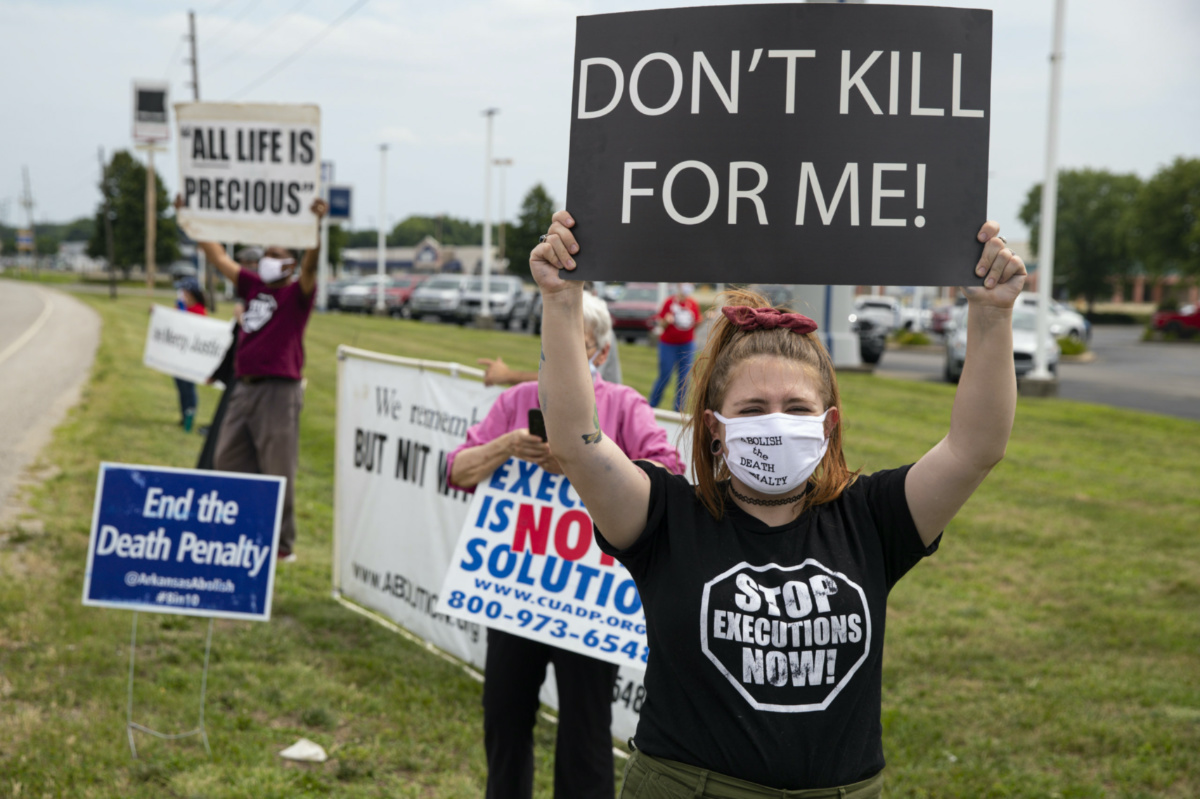
US death row pastor JOE INGLE, in an article first published on Religion News Service, says the death penalty is a “barbaric practice no matter how you package it”…
United States
RNS
I have worked with the condemned in the South since 1975. The death penalty is a barbaric practice no matter how you package it. Although Alabama officials hailed the use of nitrogen gas as the wave of the future with their recent execution of Kenneth Smith, witnesses gave a different account of the proceedings.
Despite efforts to modernize execution methods, the underlying brutality of the death penalty remains unchanged.

Protesters against the death penalty gather in Terre Haute, Indiana, on 15th July, 2020. PICTURE: AP Photo/Michael Conroy.
When a state kills a human being with a drug that some state veterinary associations have outlawed for the euthanasia of animals, that is really all you need to know about the process. Such is the case in Alabama with the use of nitrogen gas and in Tennessee with vecuronium bromide. These drugs are avoided for killing animals, but permitted for the state in killing protocols of human beings.
These ethical inconsistencies inherent in the selection of execution drugs, along with gross injustices throughout the system, underscore the moral bankruptcy of what I have come to refer to as the “killing machine”.
“[E]thical inconsistencies inherent in the selection of execution drugs, along with gross injustices throughout the system, underscore the moral bankruptcy of what I have come to refer to as the ‘killing machine’.”
The United States’ first execution of a prisoner by lethal injection happened on 7th December, 1982, in Huntsville, Texas. The prisoner’s name was Charlie Brooks. I remember because I was there.
As a death row minister, I had flown out to Texas to meet with then-Governor Bill Clements prior to the execution; I then joined a protest organized by my colleagues outside the penitentiary where the state killing would take place at midnight.
The proponents of this new “medical model” envisioned lethal injection as providing a painless, cosmetically pleasing viewing for witnesses and prison personnel. In reality, though, it was what a Florida state senator later described thusly: “It makes it easier to execute them because they are not jerking and writhing like they do in the electric chair.”
Ah, yes, an inoffensive viewing makes for a better press report.
Before the vigil was scheduled to begin, I stopped in at a local café, where I overheard two white men sitting at a table nearby discussing the upcoming execution: “He’s gittin’ off easy. This needle business is just gittin’ off easy.”
“Yup,” his companion responded. “They oughta fry” Brooks, he said, using a racial slur.
At the nearby penitentiary, my colleagues and I kept a candlelight vigil but we were not alone. The crowd, really more of a mob of several hundred, assembled and began yelling and screaming for the killing of Brooks. To this Southerner, who knows his history, this group was reminiscent of the mobs that had historically made Texas, especially eastern Texas, a leader in lynching. This section of the state also led in sentencing people to death row.
The mob carried on for several hours and then suddenly became quiet. I looked up from my candle and saw Brooks’ family slowly, painfully climbing those steps of the penitentiary for a last goodbye with a son and brother.
Although the trial court had found Brooks guilty of murder, the prosecutor subsequently requested that his death sentence be commuted over doubt as to who pulled the trigger and said he had “pangs of conscience” over the disparity between the sentences given to Brooks and his partner, who was serving 40 years with the possibility of parole. “It may well be, as horrible as it is to contemplate, that the State of Texas executed the wrong man,” the prosecutor later said.
However, it was not enough to stop the killing machine. And on the day of his execution, witnesses have said Brooks indicated he was in tremendous suffering in the seven minutes after the injection began. An injection did not go as smoothly as expected, and was reported to have had “a problem with the line,” leading to the solution being more diluted for the next execution. As Charles Colson wrote for The Washington Post at the time, “That execution wasn’t painless.”
On 28th February of this year, two executions were scheduled in the United States, of Ivan Cantu in Texas and Thomas Creech in Idaho. Cantu maintained his innocence and it was later found that two key witnesses lied in their testimony, leading some jurors on the case to express concerns over the sentence, including the jury foreman, who wrote an opinion column titled “I helped put Ivan Cantu on death row. Now I feel like I was fooled.” None of it mattered. Yet again, Texas made sure Cantu, despite significant doubt as to his guilt, died a horrific death with the “medical model.”
An NPR investigation of over 200 autopsies of the lethally injected has revealed 84 per cent experienced pulmonary edema or drowning. Additionally, doctors “raised serious concerns that many inmates are not being properly anesthetized and are therefore feeling the suffocating and drowning sensation brought on by pulmonary edema,” NPR said.
We rely on our readers to fund Sight's work - become a financial supporter today!
For more information, head to our Subscriber's page.
The second lethal injection execution attempt on 28th February – that of Creech in Idaho – was halted after eight failed attempts to find a vein while he was strapped to the gurney. Defence lawyers stated, “The badly botched execution proves the state cannot carry out an execution that is humane and constitutional.”
Consistent instances of botched executions expose the inherent flaws and inhumanity of the death penalty system, undermining its legitimacy and moral standing.
On 4th April, Michael Smith was executed by lethal injection in Oklahoma. He was convicted of murdering two people while on PCP, and under the shattering effect of that drug, gave a confession to police. He was intellectually disabled and said he had no recollection of the killing. What is accomplished by executing a man from such a context?
Brian Dorsey was convicted of murder and was executed in Missouri this week, on Tuesday. He was known for being a model prisoner. He was even the barber for the warden, and some 60 correctional officers asked for his clemency.
I worked with two men in Tennessee, Ed Zagorski and Nick Sutton, who had the qualities of Dorsey. Zagorski spent 35 years in prison without a disciplinary write-up. In 50 years of prison ministry in the South, I had never seen that for an individual on death row. Sutton hit the trifecta: Post trial, jurors stated that if they had known all of the facts they would have given him life. And correctional officers asked for clemency because he had saved their lives; he had graduated from a conflict resolution course and was a certified mediator.
Neither Zagorski nor Sutton received clemency. They were electrocuted by the state of Tennessee in an inherently political process that has nothing to do with justice. You see, by denying clemency a governor proves he is tough on crime. That is why this is a criminal legal system. What is happening is criminal. It is legal. And it is a system. It is all about politics and killing, not justice.

Razor wire surrounds a prison. PICTURE: Jody Davis/Pixabay/Creative Commons.
During my 45 years ministering to the condemned, I discerned that those on death row fall into three distinct categories: those truly guilty of murder; individuals who were unequivocally innocent; and others sentenced to death after the true perpetrator negotiated a plea deal with prosecutors, implicating their co-defendant.
Structural inequalities within the legal system perpetuate a cycle of injustice, disproportionately affecting marginalized communities and undermining the principles of fairness and equality. In other words, often it’s not committing the worst crime that lands an individual on death row, but having the worst lawyer — most cannot afford quality legal counsel.
Across the South, everyone I have met on death row has been poor. In addition, extreme racial discrimination is uncontroverted in more than 20 studies conducted across the country. What we have is a criminal legal system that delivers poor victims of racial discrimination right to the executioner’s door.
These condemned to die have been women, men, the mentally ill, the truly insane; almost all suffered from horrific childhood experiences. Many of them have suffered from trauma and brain damage. Yet I have found each to be responsive to caring, concern and empathy. Most have become my friends.
Although our criminal legal system wishes to designate them to the scrap heap, I have experienced these people to be thoughtful, engaging, funny and responsible human beings confined to cages. And despite their circumstances, those on death row retain their humanity and deserve to be treated with dignity and compassion.
When we lose the perspective that each individual is a child of God, we can do terrible things to one another. Yes, many on death row have committed murder, but none of us should be defined by the worst thing we have done, nor our humanity forfeited because of it.
Joe Ingle is a death row pastor, United Church of Christ minister and the founder of the Southern Center for Human Rights. He is the author of a forthcoming memoir, Too Close to the Flame: With the Condemned inside the Southern Killing Machine.




